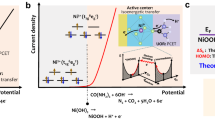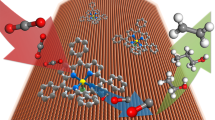Abstract
The electrochemical oxidation of alcohols is a major focus of energy and chemical conversion efforts, with potential applications ranging from fuel cells to biomass utilization and fine-chemical synthesis1,2,3,4,5,6,7. Small-molecule electrocatalysts for processes of this type are promising targets for further development8, as demonstrated by recent advances in nickel catalysts for electrochemical production and oxidation of hydrogen9,10,11. Complexes with tethered amines that resemble the active site of hydrogenases12 have been shown both to catalyse hydrogen production (from protons and electrons) with rates far exceeding those of such enzymes11,13 and to mediate reversible electrocatalytic hydrogen production and oxidation with enzyme-like performance14. Progress in electrocatalytic alcohol oxidation has been more modest. Nickel complexes similar to those used for hydrogen oxidation have been shown to mediate efficient electrochemical oxidation of benzyl alcohol, with a turnover frequency of 2.1 per second. These compounds exhibit poor reactivity with ethanol and methanol, however15. Organic nitroxyls, such as TEMPO (2,2,6,6-tetramethyl-1-piperidine N-oxyl), are the most widely studied electrocatalysts for alcohol oxidation5,6,7,16,17,18,19. These catalysts exhibit good activity (1–2 turnovers per second) with a wide range of alcohols18 and have great promise for electro-organic synthesis7. Their use in energy-conversion applications, however, is limited by the high electrode potentials required to generate the reactive oxoammonium species. Here we report (2,2′-bipyridine)Cu/nitroxyl co-catalyst systems for electrochemical alcohol oxidation that proceed with much faster rates, while operating at an electrode potential a half-volt lower than that used for the TEMPO-only process. The (2,2′-bipyridine)Cu(II) and TEMPO redox partners exhibit cooperative reactivity and exploit the low-potential, proton-coupled TEMPO/TEMPOH redox process rather than the high-potential TEMPO/TEMPO+ process. The results show how electron-proton-transfer mediators, such as TEMPO, may be used in combination with first-row transition metals, such as copper, to achieve efficient two-electron electrochemical processes, thereby introducing a new concept for the development of non-precious-metal electrocatalysts.
This is a preview of subscription content, access via your institution
Access options
Subscribe to this journal
Receive 51 print issues and online access
$199.00 per year
only $3.90 per issue
Buy this article
- Purchase on Springer Link
- Instant access to full article PDF
Prices may be subject to local taxes which are calculated during checkout




Similar content being viewed by others
References
Kakati, N. et al. Anode catalysts for direct methanol fuel cells in acidic media: do we have any alternative for Pt or Pt−Ru? Chem. Rev. 114, 12397–12429 (2014)
Bianchini, C. & Shen, P. K. Palladium-based electrocatalysts for alcohol oxidation in half cells and in direct alcohol fuel cells. Chem. Rev. 109, 4183–4206 (2009)
Cheung, K.-C., Wong, W.-L., Ma, D.-L., Lai, T.-S. & Wong, K.-Y. Transition metal complexes as electrocatalysts—development and applications in electro-oxidation reactions. Coord. Chem. Rev. 251, 2367–2385 (2007)
Trincado, M., Banerjee, D. & Grützmacher, H. Molecular catalysts for hydrogen production from alcohols. Energy Environ. Sci. 7, 2464–2503 (2014)
Hickey, D. P., McCammant, M. S., Giroud, F., Sigman, M. S. & Minteer, S. D. Hybrid enzymatic and organic electrocatalytic cascade for the complete oxidation of glycerol. J. Am. Chem. Soc. 136, 15917–15920 (2014)
Cha, H. G. & Choi, K.-S. Combined biomass valorization and hydrogen production in a photoelectrochemical cell. Nat. Chem. 7, 328–333 (2015)
Ciriminna, R., Palmisano, G. & Pagliaro, M. Electrodes functionalized with the 2,2,6,6-tetramethylpiperidinyloxy radical for the waste-free oxidation of alcohols. ChemCatChem 7, 552–558 (2015)
Francke, R. & Little, R. D. Redox catalysis in organic electrosynthesis: basic principles and recent developments. Chem. Soc. Rev. 43, 2492–2521 (2014)
Rakowski Dubois, M. & Dubois, D. L. Development of molecular electrocatalysts for CO2 reduction and H2 production/oxidation. Acc. Chem. Res. 42, 1974–1982 (2009)
Le Goff, A. et al. From hydrogenases to noble metal-free catalytic nanomaterials for H2 production and uptake. Science 326, 1384–1387 (2009)
Raugei, S. et al. Experimental and computational mechanistic studies guiding the rational design of molecular electrocatalysts for production and oxidation of hydrogen. Inorg. Chem. 55, 445–460 (2016)
Rauchfuss, T. B. Diiron azadithiolates as models for the [FeFe]-hydrogenase active site and paradigm for the role of the second coordination sphere. Acc. Chem. Res. 48, 2107–2116 (2015)
Helm, M. L., Stewart, M. P., Bullock, R. M., Rakowski DuBois, M. & DuBois, D. L. A synthetic nickel electrocatalyst with a turnover frequency above 100,000 s−1 for H2 production. Science 333, 863–866 (2011)
Rodriguez-Maciá, P., Dutta, A., Lubitz, W., Shaw, W. J. & Rüdiger, O. Direct comparison of the performance of a bio-inspired synthetic nickel catalyst and a [NiFe]-hydrogenase, both covalently attached to electrodes. Angew. Chem. Int. Ed. 54, 12303–12307 (2015)
Weiss, C. J., Wiedner, E. S., Roberts, J. A. S. & Appel, A. M. Nickel phosphine catalysts with pendant amines for electrocatalytic oxidation of alcohols. Chem. Commun. 51, 6172–6174 (2015)
Bobbitt, J. M., Brückner, C. & Merbouh, N. Oxoammonium- and nitroxide-catalyzed oxidations of alcohols. Org. React. 74, 103–424 (2009)
Semmelhack, M. F., Chou, C. S. & Cortes, D. A. Nitroxyl-mediated electrooxidation of alcohols to aldehydes and ketones. J. Am. Chem. Soc. 105, 4492–4494 (1983)
Rafiee, M., Miles, K. C. & Stahl, S. S. Electrocatalytic alcohol oxidation with TEMPO and bicyclic nitroxyl derivatives: driving force trumps steric effects. J. Am. Chem. Soc. 137, 14751–14757 (2015)
Hickey, D. P. et al. Predicting electrocatalytic properties: modeling structure-activity relationships of nitroxyl radicals. J. Am. Chem. Soc. 137, 16179–16186 (2015)
Ryland, B. L. & Stahl, S. S. Practical aerobic oxidations of alcohols and amines with homogeneous copper/TEMPO and related catalyst systems. Angew. Chem. Int. Ed. 53, 8824–8838 (2014)
Semmelhack, M. F., Schmid, C. R., Cortes, D. A. & Chou, C. S. Oxidation of alcohols to aldehydes with oxygen and cupric ion, mediated by nitrosonium ion. J. Am. Chem. Soc. 106, 3374–3376 (1984)
Dijksman, A., Arends, I. W. C. E. & Sheldon, R. A. Cu(II)-nitroxyl radicals as catalytic galactose oxidase mimics. Org. Biomol. Chem. 1, 3232–3237 (2003)
Hoover, J. M., Ryland, B. L. & Stahl, S. S. Mechanism of copper(I)/TEMPO-catalyzed aerobic alcohol oxidation. J. Am. Chem. Soc. 135, 2357–2367 (2013)
Ryland, B. L., McCann, S. D., Brunold, T. C. & Stahl, S. S. Mechanism of alcohol oxidation mediated by copper(II) and nitroxyl radicals. J. Am. Chem. Soc. 136, 12166–12173 (2014)
Whittaker, J. W. Free radical catalysis by galactose oxidase. Chem. Rev. 103, 2347–2364 (2003)
Chirik, P. J. & Wieghardt, K. Radical ligands confer nobility on base-metal catalysts. Science 327, 794–795 (2010)
Costentin, C. & Savéant, J.-M. Multielectron, multistep molecular catalysis of electrochemical reactions: benchmarking of homogeneous catalysts. ChemElectroChem 1, 1226–1236 (2014)
Semmelhack, M. F., Schmid, C. R. & Cortes, D. A. Mechanism of the oxidation of alcohols by 2,2,6,6-tetramethylpiperidine nitrosonium cation. Tetrahedr. Lett. 27, 1119–1122 (1986)
Huynh, M. H. V. & Meyer, T. J. Proton-coupled electron transfer. Chem. Rev. 107, 5004–5064 (2007)
Warren, J. J., Tronic, T. A. & Mayer, J. M. Thermochemistry of proton-coupled electron transfer reagents and its implications. Chem. Rev. 110, 6961–7001 (2010)
Acknowledgements
Financial support for this project was provided by the Great Lakes Bioenergy Research Center (Department of Energy Biological and Environmental Research Office of Science DE-FC02-07ER64494).
Author information
Authors and Affiliations
Contributions
S.S.S. conceived the idea for the Cu/nitroxyl electrocatalytic alcohol oxidation, and A.B. and S.S.S. collaborated to design the project. A.B. performed all experimental work and led the data interpretation and analysis, in consultation with S.S.S. A.B. and S.S.S. wrote the manuscript.
Corresponding author
Ethics declarations
Competing interests
The authors declare no competing financial interests.
Supplementary information
Supplementary Information
This file contains Supplementary Text and Data, Supplementary Figures 1 – 23 and additional references (see Contents for more details). (PDF 10424 kb)
Rights and permissions
About this article
Cite this article
Badalyan, A., Stahl, S. Cooperative electrocatalytic alcohol oxidation with electron-proton-transfer mediators. Nature 535, 406–410 (2016). https://doi.org/10.1038/nature18008
Received:
Accepted:
Published:
Issue Date:
DOI: https://doi.org/10.1038/nature18008
This article is cited by
-
Operando formation of highly efficient electrocatalysts induced by heteroatom leaching
Nature Communications (2024)
-
Paired electrocatalysis unlocks cross-dehydrogenative coupling of C(sp3)-H bonds using a pentacoordinated cobalt-salen catalyst
Nature Communications (2024)
-
Organomediated electrochemical fluorosulfonylation of aryl triflates via selective C–O bond cleavage
Nature Communications (2023)
-
Metal-free electrochemical dihydroxylation of unactivated alkenes
Nature Communications (2023)
-
Electrochemical chemo- and regioselective arylalkylation, dialkylation and hydro(deutero)alkylation of 1,3-enynes
Nature Synthesis (2023)
Comments
By submitting a comment you agree to abide by our Terms and Community Guidelines. If you find something abusive or that does not comply with our terms or guidelines please flag it as inappropriate.



